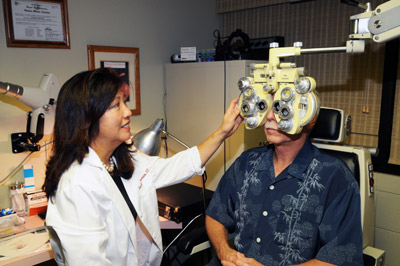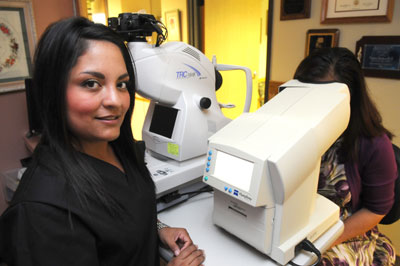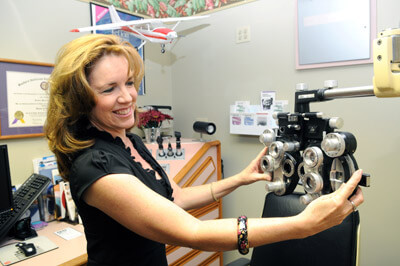
Comprehensive Eye Examinations are customized for your visual needs. Your comprehensive eye examination may include the following tests:
- Your Personal Health History, which will help us find out a little about you, your work, your hobbies and all that we need to know so we can help you to see clearly.
- Medical and Eye History of you and your family members. Some conditions that affect the body, such as diabetes, high blood pressure and cholesterol, can also affect the eyes and vision. So, it is important for us to familiarize ourselves with your medical history and the medications that you take. Some eye and health conditions can run in families, so it is helpful to know which of these might affect you and the health of your eyes.
- Muscle Balance Test to evaluate your eyes' ability to work together as a team
- Neurological Test to be sure that the cranial nerves that control your eye reflexes, responses to light and eye movements, are all functioning normally
- Visual Field Screening Test to test the peripheral vision. Conditions such as glaucoma, retinitis pigmentosa, retina detachments and previous strokes, can affect the peripheral vision.
-
Refraction is the testing of the different lens powers to determine which power will allow you to see clearly in the distance.

-
Visual Acuity is a measure of the sharpness of your vision.
- In the 20/20 notation, the first 20 refers to the testing distance in feet, in this case, 20 feet.
- The denominator, or second number, is the size of a letter that you can see. The 20 size letter is very small and the 200 size is 10 times as large.
-
Another way to think of it is that a person who has 20/20 vision standing at 200 feet, would see the same amount of detail as a person who has
20/200 vision, standing at 20 feet.

- Near Vision Tests measures the amount of lens power needed for you to see clearly for reading.
-
Evaluation of the structures of the eye:
- The Biomicroscope or “Slit-Lamp” allows us to examine the front structures of the eye; lids, lashes, tears, cornea, conjunctiva, sclera, iris, lens.
- The Ophthalmoscope or Binocular Indirect Ophthalmoscope allows us to examine the retina, optic nerve and blood vessels inside of the eye. This is best done through a dilated pupil.
- Tonometry measures the intraocular pressure or the pressure inside of the eye. This is one of the tests that we do to test for glaucoma.
Request an Appointment
Schedule your appointment today with Riverside Optometry or call us at (951) 784-2420. We are excited to serve you and your family!









